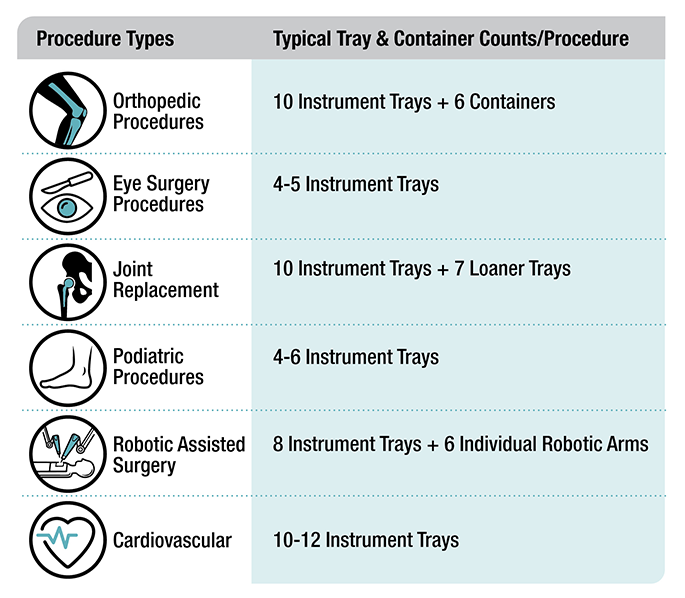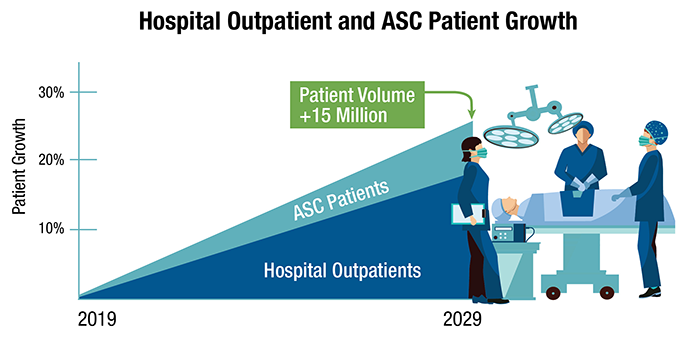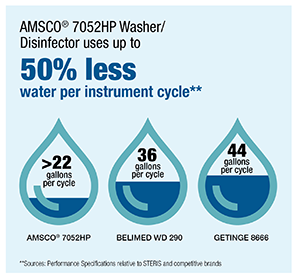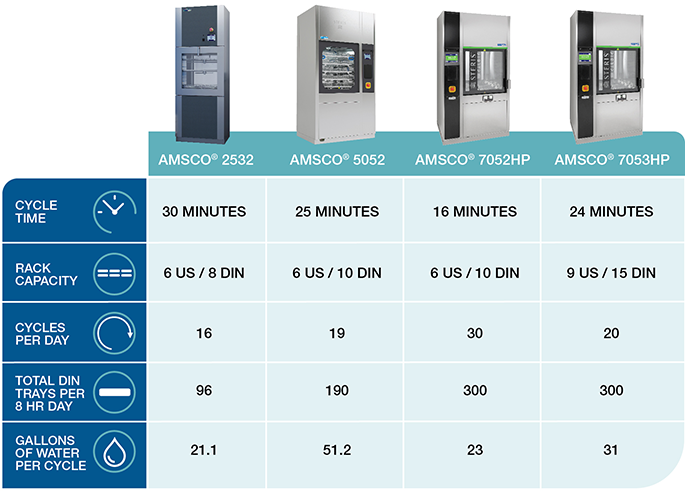Key Considerations When Selecting a Washer/Disinfector
There are several considerations when planning for a washer/disinfector purchase, and it begins with reviewing the devices that need to be processed in that washer/disinfector. What is your current instrument and rigid container inventory? How often does it need to be reprocessed to support your case load? What about your caseload 6 months from now, or even 3 years from now?
Tracking and understanding the data to identify the right washer/disinfector to support the sterile processing department (SPD) is important. While it is impossible to precisely predict future needs, here are a few areas to review when planning for a new washer/disinfector:
- Throughput & Capacity – How many devices do you process daily, and how quickly do you need to process those devices to support Operating Room (OR) needs?
- Device Alignment - What cycle types are used to support your overall volume?
- Cost - What are some economical options and what is your long-term Total Cost of Ownership?
today's needs for today's procedures
When selecting a new washer/disinfector, you first need to quantify your facility's current needs. Use this set of questions to understand your needs:
-
How many cases per day, on average?
-
How many instruments/trays are needed for an average case?
-
How many cases require large containers?
-
How many other utensils require reprocessing with washer/disinfectors?
-
How long is a typical cycle in your washer/disinfector?
-
How often does your department experience a backlog as devices wait for an available washer/disinfector?
-
Where will the washer/disinfector go – are there any space constraints?
These questions will help you determine if your current washer/disinfectors adequately support your throughput needs.
For facilities performing complex procedures, including orthopedic, podiatric, or joint replacements, the number of trays required is often far greater than for a typical surgery. Orthopedic procedures, for example, can require up to 10 trays of instruments and 6 containers.
The below graphic illustrates that all procedures are not equal, so understanding the type and quantity of procedures is an important first step in washer/disinfector selection.

Volume isn't the only consideration for procedures; instrument type/componentry is just as important. It will help you understand the processing time required for more complex devices. Ask yourself the following questions:
- What types of instruments are you currently processing?
- What are the reprocessing requirements detailed in those instruments' Instruction For Use (IFUs)?
- What are your common cases? Orthopedic cases, for example, can use many devices, while instruments for eye surgery require special processing.
- What are your processing needs for robotic instruments?
Understanding which device types are being processed will help you determine your instrument washer/disinfector needs. For example, some of the surgical instruments used for today's robotic procedures are not overwhelming from a space/tray standpoint, but the IFUs may require additional reprocessing considerations.
The AMSCO 7052HP/7053HP Washer/Disinfector is a smart choice because it has a validated Robotic Assisted Surgery cycle for select daVinci* instruments.
Tomorrow's Needs and Beyond
Once today's requirements are established, planning for future growth should be considered. While most facilities keep the same washer/disinfector for 8 years, others may choose to maintain older equipment until repairs become more frequent and impact uptimes.
When planning for the future, ask these questions:
- What will your procedure and instrument makeup look like in 3 months, or 3 years?
- What type of expansion is planned – relative to operating rooms or procedure types?
- What are the growth expectations relative to your current surgeries and procedures?
Forecasts project that inpatient hospital volumes will recover to its pre-COVID-19 levels in 2022 and then plateau. However, if you are a smaller ambulatory surgery center (ASC), caseloads are growing 6% to 7% each year1, with orthopedic, cardio, and spine procedures growing the fastest.
Hospital Outpatient Departments (HOPD) and ASCs will experience rapid patient growth (19% and 25% by 2029, respectively), experiencing a patient volume that is 15 million higher in 2029 than in 20192.

Technology also continues to drive instrument innovation. Minimally invasive techniques and robotic procedures require special manual cleaning considerations to follow specific IFUs.

With the instances of robotic surgery for common surgical procedures growing from 1.8% in 2012 to 15.1% in 20183, the future shows a need for more reprocessing solutions to support these procedures. Choosing the correct washer/disinfector is important for planning to handle this changing landscape in the future.
After you know the basics, some of the answers will likely lead to follow-up questions that can help you determine your future needs.
There are tangible costs to purchase the washer, utilities needed to run the washer, and the cost of chemistry to support processing. Here are some questions to ask when considering a new washer/disinfector that will help you look at cost & efficiency:
- How much water does your current washer/disinfector use per cycle?
- Does your washer/disinfector allow for Ultra Concentrated chemistries?
- Have you considered connectivity? Connecting to an instrument tracking software provides electronic record keeping to help you be more audit ready.
- How efficient is each cycle when looking at ongoing chemistry and utility usage?
Reducing Utility and Environmental Impact
 Today's modern washer/disinfectors use up to 50% less water per instrument cycle compared to older models**. Saving water decreases your facility's environmental impact and reduces utility costs.
Today's modern washer/disinfectors use up to 50% less water per instrument cycle compared to older models**. Saving water decreases your facility's environmental impact and reduces utility costs.
Ultra-concentrated chemistries can save facilities money, drive compliance, and deliver better instrument cleaning.
Modern washer/disinfectors that use High Performance (HP), Ultra-Concentrated chemistries can provide direct savings for your department.
Not only can Prolystica Ultra-Concentrate HP chemistries clean difficult soils faster and more thoroughly, but the ultra-concentrated formulations also mean fewer containers, providing decreased cost for shipping and storage.
Consider & Compare
By answering the above questions and considering the future surgical support needs, you can make a more informed decision for your next washer/disinfector purchase. Using the chart below, you can compare capacity, cycle-time, and utility usage for the most popular STERIS washer/disinfectors.

Explore STERIS Washer/Disinfectors
Article References
1 Ambulatory Surgery Center Growth Accelerates: Is Medtech Ready? Tim van Biesen and Todd Johnson, Bain & Company 2019
2 Impact of Change Forecast Predicts Enormous Disruption in Health Care Provider Landscape by 2029 – Vizient, Inc. and its subsidiary Sg2 – 2021 Impact of Change® Forecast
3 Sheetz KH, Claflin J, Dimick JB. Trends in the Adoption of Robotic Surgery for Common Surgical Procedures. JAMA Netw Open. 2020;3(1):e1918911. doi:10.1001/jamanetworkopen.2019.18911
* The RAS Racks are used in the RAS Cycle of the AMSCO 7052HP Single-Chamber Washer/Disinfector and the AMSCO 7053HP Single-Chamber Washer/Disinfector for the effective cleaning, rinsing, intermediate level disinfection and drying of reusable da Vinci® X/Xi and S/Si EndoWrist® instruments. da Vinci®, EndoWrist® are registered trademarks of Intuitive Surgical.
 United States
United States
 Canada (EN)
Canada (EN) Canada (FR)
Canada (FR) Deutschland
Deutschland Italia
Italia United Kingdom
United Kingdom Australia
Australia New Zealand
New Zealand Singapore
Singapore Brasil
Brasil México
México



 Today's modern washer/disinfectors use up to 50% less water per instrument cycle compared to older models**. Saving water decreases your facility's environmental impact and reduces utility costs.
Today's modern washer/disinfectors use up to 50% less water per instrument cycle compared to older models**. Saving water decreases your facility's environmental impact and reduces utility costs.

